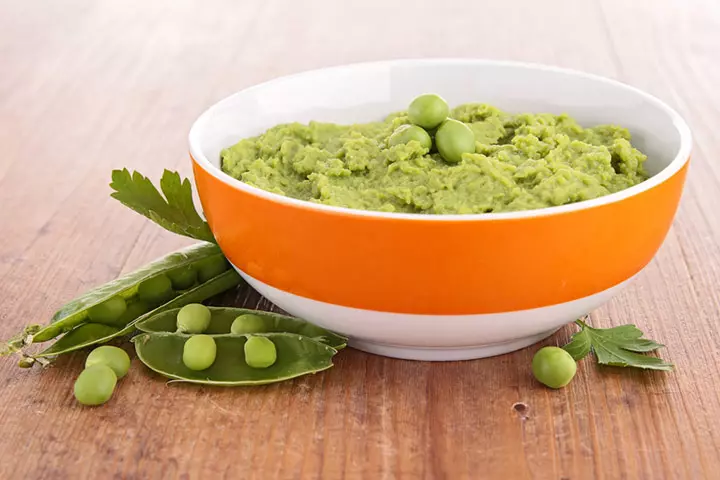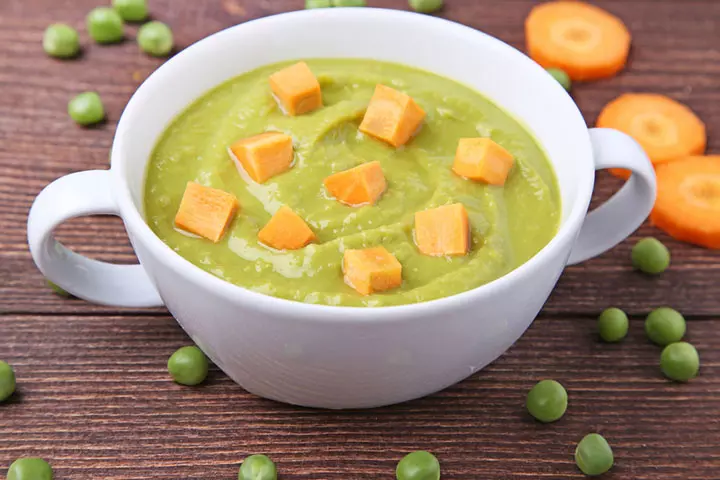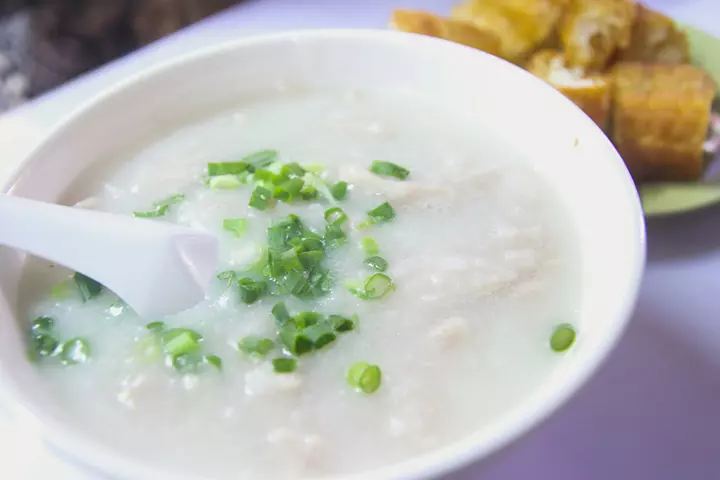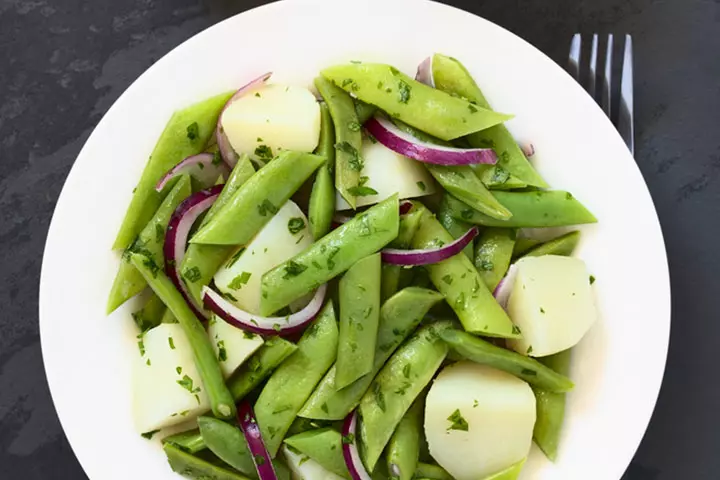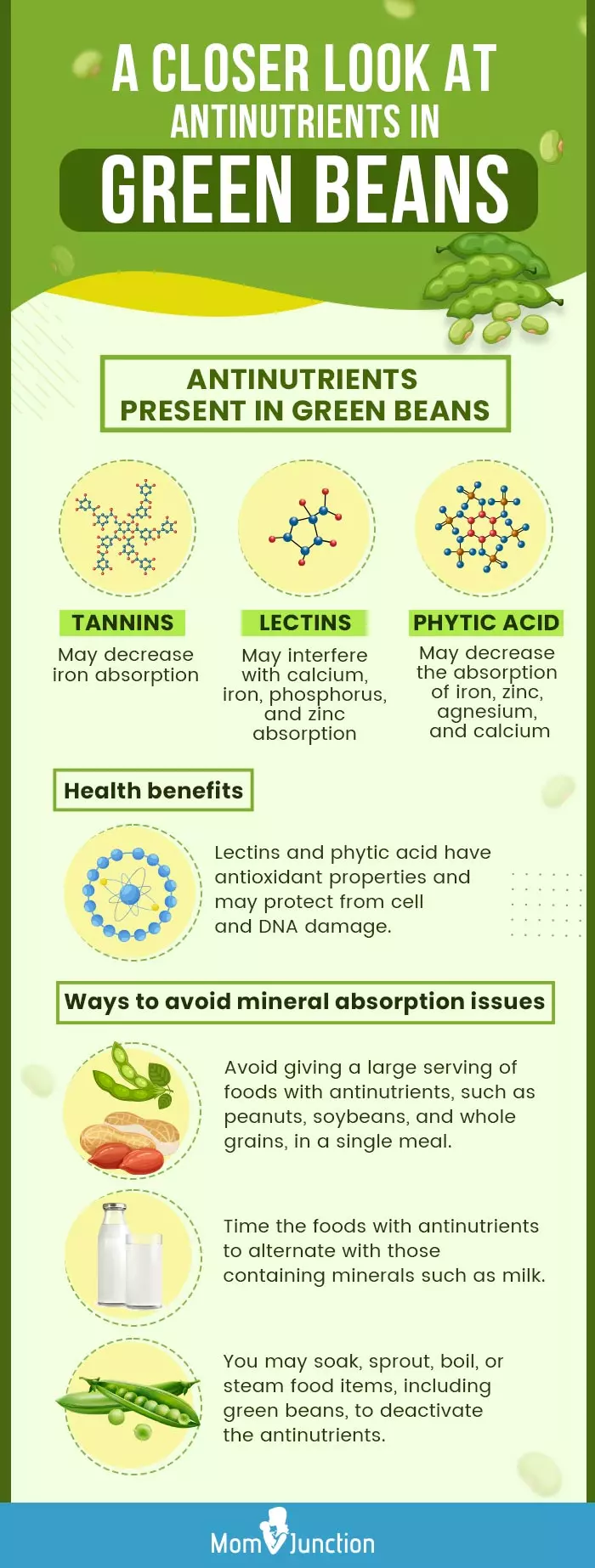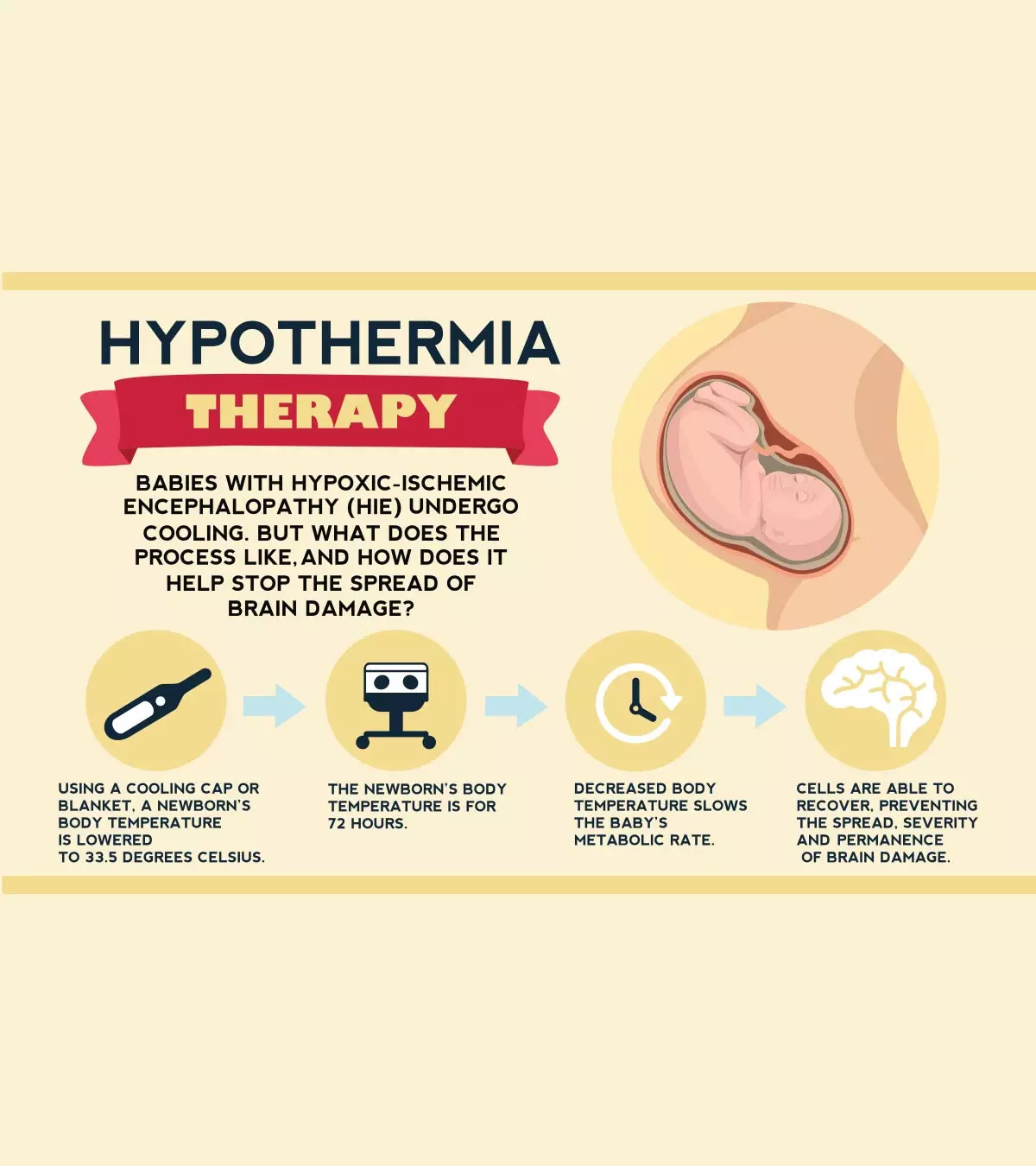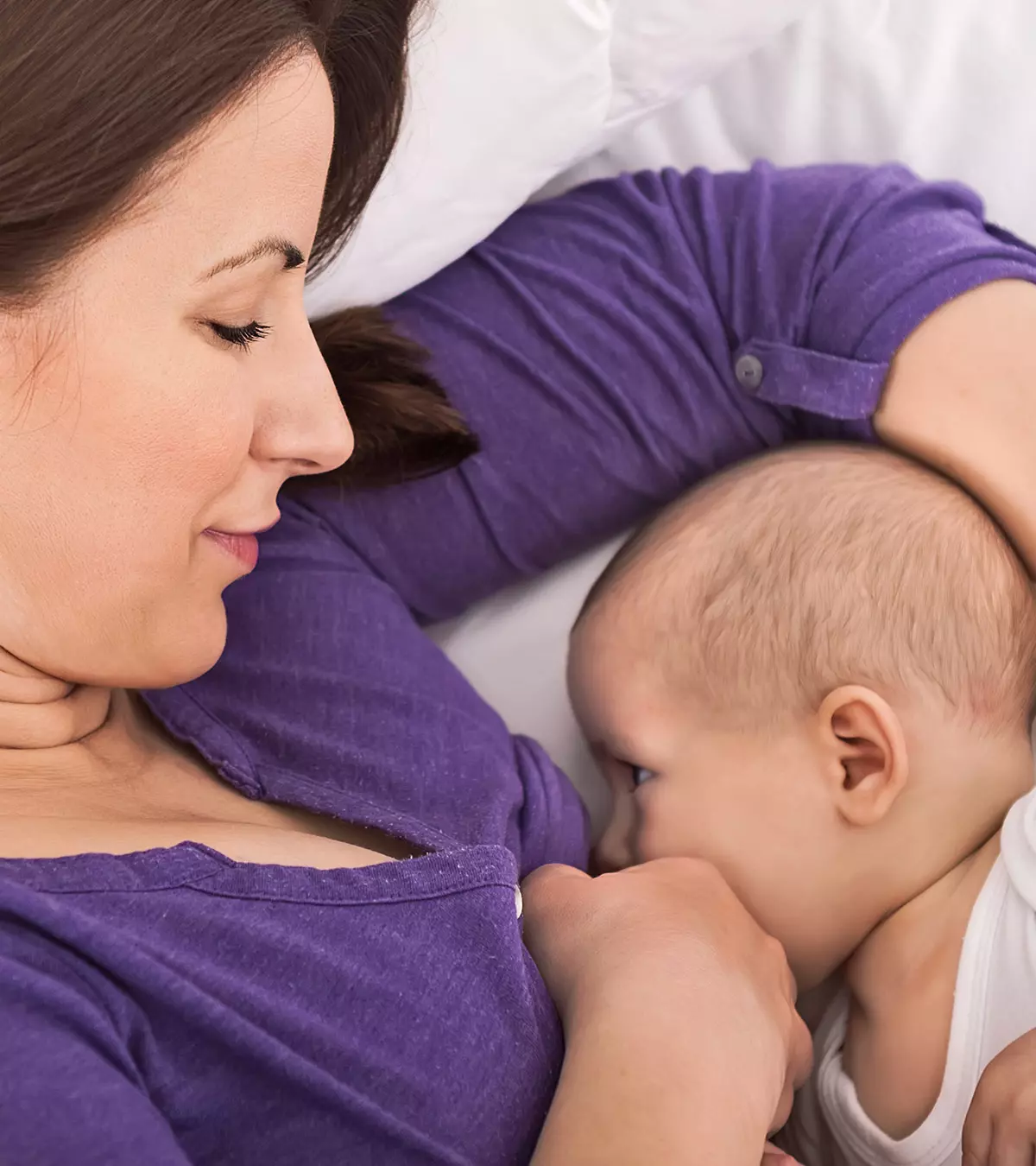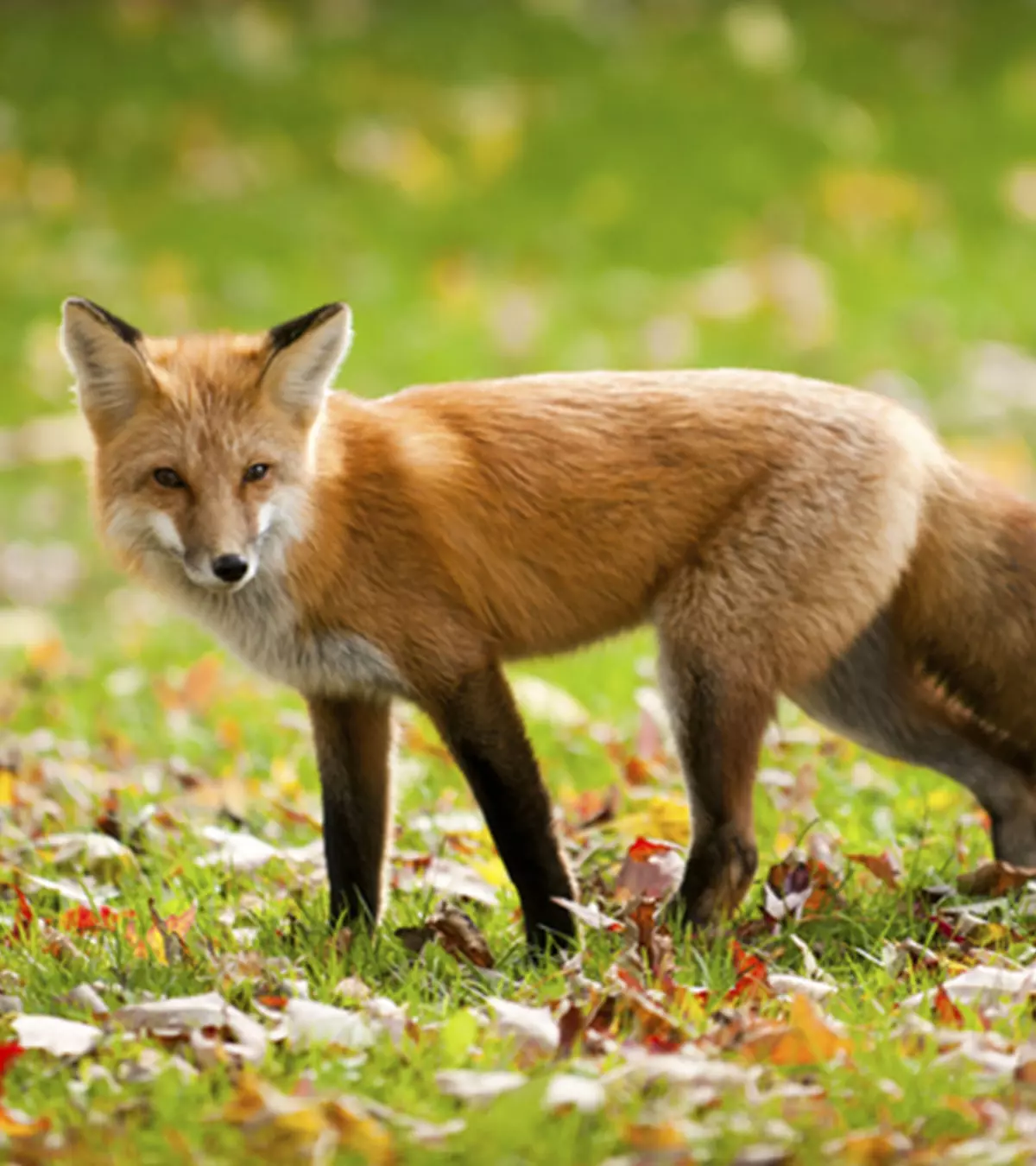

Image: Shutterstock
Despite their botanical status as fruit, green beans are often referred to as vegetables high in fiber, essential vitamins and minerals, and protein. However, most parents are hesitant to introduce green bean baby food because it contains naturally occurring nitrates, inducing flatulence (1).
This post discusses how to feed green beans to babies, some baby-friendly green bean recipes, and the various advantages of feeding green beans to babies.
When Can Babies Have Green Beans?
You can include green beans in the baby’s diet after they turn six months old (1). It is recommended to not introduce green beans in a baby meal before three months (in any form) as the naturally occurring nitrates in it could have negative impacts on the baby’s health (2). Also, green beans can be hard to puree due to their rich fiber content, and, therefore, some experts recommend introducing the beans after nine months (3).
How Are Babies Likely To Benefit From Green Beans Consumption?
Green beans, also called snap beans, contain several nutrients that play a vital role in the healthy growth of an infant.
- Vitamins: Green beans are rich in beta-carotene, which is the precursor compound for the formation of vitamin A in the body. Vitamin A keeps the retinal cells healthy and prevents their premature degeneration, which could eventually help in improving vision (4).
- Minerals: Green beans contain carotenoids, and several vitamins and minerals such as vitamin A, iron, potassium, manganese, and calcium. These micronutrients are vital for developing a healthy immune system (5).
- Source of vitamins for infants with gluten allergy: Infants with gluten allergy tend to be at the risk of developing vitamin B deficiency, which in turn can affect healthy growth. However, green beans can be used instead of grains as they contain the same B vitamins, and in similar quantities, found in grains (6). Apart from the B vitamins, green beans have other vital vitamins like vitamins A, C, and K that play a prominent role in the growth and development of babies.
- Dietary fiber: According to Nutrition Database, USDA, 100gm of raw green beans provide approximately 31Kcal and 2.7gm of total dietary fiber, which means it could be used to increase the satiety value of the meal. Experts often recommend green beans in an infant’s diet, as the long-term consumption of this vegetable can help cut down the risk of childhood obesity later (7).
- Antioxidants: The fiber and antioxidants present in green beans are said to aid in cell functioning and may even reduce the risk of certain cancers (8). Green beans may also aid in keeping the cell metabolism right on track and stimulating healthy growth, which in turn helps a baby achieve developmental milestones in time (4).
Note:
Green beans have an anti-nutritional compound called phytic acid, which tends to bind free minerals and render them unavailable to the body for absorption. Boiling or cooking the vegetable after soaking can help reduce the concentration of phytic acid and enhance the bioavailability of minerals (9).
Nutritional Value Per 100g Of Green Beans
| Nutrient | Unit Value Per 100g |
|---|---|
| Energy | 31kcal |
| Carbohydrates | 6.97g |
| Natural sugars | 3.26g |
| Fiber | 2.7g |
| Protein | 1.83g |
| Fat | 0.22g |
| Calcium | 37 mg |
| Iron | 1.03mg |
| Magnesium | 25mg |
| Phosphorus | 38mg |
| Potassium | 211mg |
| Sodium | 6mg |
| Manganese | 0.216mg |
| Copper | 0.069mg |
| Zinc | 0.24mg |
| Selenium | 0.6µg |
| Fluoride | 19µg |
| Vitamin C | 12.2mg |
| Vitamin B1 (Thiamin) | 0.082mg |
| Vitamin B2 (Riboflavin) | 0.104mg |
| Vitamin B3 (Niacin) | 0.734mg |
| Vitamin B5 (Pantothenic acid) | 0.225mg |
| Vitamin B6 | 0.141mg |
| Vitamin B9 (Folate) | 33µg |
| Choline | 15.3mg |
| Vitamin A | 35µg |
| Vitamin E | 0.41mg |
| Vitamin K | 43µg |
Source:United States Department of Agriculture (10)
[Read: Baby’s First Foods]
How To Select And Store Green Beans?
Here is how to select and store green beans before preparing them for the baby to eat (11).
1. Selection: Choose green beans that are bright in color and do not have any blemishes on them. Do not choose the ones that have any holes as they indicate the presence of pests within. Hold the beans between your hands and bend it. You will feel resistance. This indicates the suppleness and freshness of beans. Fresh beans also break with a crispy snap. Beans that bend easily yet do not break could be overripe and would feel soggy. Avoid these as they often taste unpleasant.
2. Storage: Wash the beans thoroughly once you get them home. Cut away the stalk and the tough end at the bottom. Transfer the beans to a plastic zip-lock pouch and store it in the refrigerator. Green beans can stay fresh up to five days, although it is best to process and cook them within a couple of days of purchase. Avoid frozen green beans for baby food as they may be prone to bacterial contamination, and their nutritional value too is not as good as the fresh produce.
Next, we tell you about a few ways to cook fresh beans for babies.
How To Cook Green Beans For Baby Food?
Green beans can be cooked in many ways depending on your preference.
1. Boiling
This is perhaps the most convenient choice for several parents. Here is how you can boil green beans to make them edible and nutritious for babies.
- Wash the beans and chop them into smaller pieces.
- Transfer them to a cooking pan with enough water to submerge the chopped beans.
- Place the pan on the cooking flame and bring the water to boil. Once the water comes to boil, turn the flame to low and cook for 15 minutes.
- You can also cook green beans in a pressure cooker, with less water. Transfer about 350gm of beans into a pressure cooker with four-six tablespoons of water. Keep in mind that the water and beans should not exceed the two-thirds capacity of the pressure cooker.
- Close the lid and cook on full flame. Once you hear one whistle, turn the flame to medium and cook for two to three minutes.
2. Steaming
This process can be done in two ways – either using a steamer basket or by microwaving.
- Pour about an inch of water in a cooking vessel.
- Place chopped beans in a steamer basket and place them within the cooking vessel. Cook on a medium flame for ten minutes with the lid partially closed.
- To steam in a microwave oven, take a large microwave cooking vessel. Pour 1/4 cup water, add chopped beans, cover the lid, and cook on full power for two minutes.
- Stir the beans and cook for a couple of minutes again. You can cook in intervals of two minutes till you get the desired tenderness of the beans.
3. Shallow frying
This method is ideal when you are cooking beans for finger foods and in small quantities. Here is how you do it:
- Cut the beans into smaller pieces, about half-an-inch in length.
- Heat about a tablespoon of vegetable oil in a cooking pan. Transfer the beans and stir fry them for five minutes or till the beans become tender enough for the baby to eat.
4. Baking
Baking, also called oven-roasting, makes green beans quite crispy, which is ideal when you want to give the vegetable as finger food. Here is how you bake green beans for babies:
- Preheat the oven to 425°F (218°C).
- Chop the green beans into smaller pieces, of about an inch long.
- Take a large baking bowl. Put the beans into it. Pour 1/3 teaspoon vegetable oil onto the green beans and mix them well.
- Bake for 10 minutes. Remove from the oven and shuffle the beans in the bowl. Bake again for 10 minutes to complete the baking process.
These are a few easy ways to cook the vegetable for your baby. You can also combine this vegetable with other foods to make it more nutritious and healthier for the baby.
Green Beans Baby Food Combinations
Combine green beans with the following food items to make tasty baby food recipes.
- Vegetables: Green beans go well with almost every vegetable, especially with root and tuber vegetables such as carrots and potatoes.
- Meat: Boiled chunks of meat and green beans make filling finger food for an infant.
- Cereals: Green beans can help create appealing and nutritious recipes when added to cereals like semolina, rice, quinoa, and oats, which otherwise taste little bland.
In the next section, we tell you how to add green beans to the baby’s food.
Yummy And Healthy Green Beans Baby Food Recipes
Green beans are nourishing and can be used to make healthy foods for babies. Here are five recipes using green beans that are suitable babies.
1. Green beans and peas puree
Image: Shutterstock
This is a green delight packed with protein, vitamins, and fiber for the baby.
You will need:
- 1 cup chopped green beans
- 1 cup green peas
- 4-5 cups of water
How to:
- Boil the peas separately in a cooking vessel with enough water to submerge all the peas. Cook for 25 minutes on medium flame.
- Boil the green beans for 15 minutes in shallow water, on low flame.
- Let the green beans and peas cool a bit. Transfer them to a blender and blend to the desired consistency.
2. Carrot and green beans puree
Image: Shutterstock
Both carrots and green beans are an excellent source of vitamin A for a baby, thus making this preparation a rich vitamin A meal for an infant.
You will need:
- 1 cup diced carrots
- 1 cup finely chopped green beans
- 4-5 cups of water
How to:
- Boil carrots in a cooking vessel for 20-25 minutes on a medium flame, with a slightly closed lid on the vessel.
- Boil green beans the usual way and then let the vegetable cool.
- Transfer into a blender, add some water and blend till you achieve the desired consistency.
3. Green peas and rice porridge
Image: Shutterstock
Combine rice and green beans to make a delicious porridge that makes a nutritious meal.
You will need:
- 2 cups of rice
- 1 cup chopped green beans
- 4-5 cups of water
How to:
- Cook rice by boiling it while you boil the beans separately.
- Transfer the cooked rice and green beans into a blender and blend them coarsely, till they mix properly.
4. Roasted baby potatoes and green beans
Image: Shutterstock
You will need:
- 1 cup peeled baby potatoes
- 1 cup chopped green beans
- 1/4 teaspoon salt
- 1 tablespoon vegetable oil
How to:
- Cut the baby potatoes in half.
- Transfer the potatoes and chopped green beans into a bowl. Add oil, salt, and mix them well.
- Place some baking paper on a baking tray and transfer the vegetables on to it.
- Preheat the oven to 450°F (232°C). Place the baking tray with the vegetables into the oven and bake for 25 minutes.
- Cool the vegetables before serving.
5. Green beans and chicken
Image: Shutterstock
Green beans, along with chicken pieces, make delicious finger food for older infants.
You will need:
- 1 cup boneless chicken pieces
- 1 cup chopped green beans
- 4-5 cups of water
How to:
- Cut the chicken pieces into smaller chunks so that it is easier for the baby to eat.
- Boil the chicken for 25 minutes on medium flame with the lid partially closed.
- Cut the green beans to about the size of half an inch. Boil them for 20 minutes on medium flame.
- Let the vegetables cool and then mix them with the chicken and serve.
Green beans can play a vital role in nourishing a baby’s growth, but they may be unsuitable for infants in some cases.
Can Babies Be Allergic To Green Beans?
Yes. Green beans belong to the legume family, which contains pulses and other beans, including soybeans that are often associated with allergies. A baby can be allergic to green beans if they are allergic to other legumes, due to what is known as legume cross-reactivity (12). So be extra cautious about introducing green beans to an infant who has a confirmed allergy of some other legume.
The symptoms of green bean allergy are quite like other food allergy symptoms, such as skin hives, vomiting, nausea, abdominal pain, swelling of the face, and lethargy. An extreme form of green bean allergy can cause food protein-induced enterocolitis syndrome (FPIES), which displays food allergy symptoms in their severe form (13). If you suspect the infant is displaying any signs of allergy, then rush him to a doctor right away for timely diagnosis and treatment.
Green beans are nutritious, and if your baby accepts it without any allergies, then you should undoubtedly make the vegetable a part of the baby’s regular diet. Next, we answer a few commonly asked questions about green beans for babies.
Frequently Asked Questions
1. Should I select organic green beans for my baby?
Green beans can contain remnant traces of pesticides, thus leaving the vegetable contaminated (14). If you have an option to buy organic green beans from a trusted source, then it is best to choose that.
2. Can green beans cause gas in babies?
The quantity of beans decides whether your baby will have gas. The gas caused by green beans is usually due to its high fiber content. So, it is always wise to feed green beans to your baby in small quantities initially, and then increase the quantity to a level that your baby is comfortable with. This will help in preventing the formation of gas too (15).
3. Do green beans prevent constipation in infants?
Green beans are rich in fiber and could help ease constipation in babies. Experts recommend making green beans a part of a baby’s diet to fight constipation (16).
Green beans are rich in vitamins such as A, C, B, and K, essential minerals, antioxidants, fiber, and many other nutrients. These nutrient-rich green beans are a very good choice of first foods for babies. However, babies younger than three months should not be given green beans. Choose bright green, hole-free, fresh, organic, and crisp green beans for your infant. It is suggested not to use beans stored for five days or more. You can try interesting recipes by either boiling, steaming, baking, or pan-frying green beans for your little one.
Infographic: Antinutrients In Green Beans
Green beans may contain certain antinutrients, but does it mean you must not serve them often to your baby? The infographic below gives you an insight into what effects they might have and how to obtain maximum benefits. Illustration: Momjunction Design Team
References
1. Homemade Baby Food: The Danger of Nitrates; Nationwide Children’s Hospital
2. Monica Preboth; AAP Clinical Report on Infant Methemoglobinemia; American Academy of Family of Physicians.
3. Feeding Guide for the First Year; Healthy Encyclopedia; University of Rochester Medical Center Rochester, NY
4. 6 Health Benefits of Green Beans; EBPCOOH
5. Green Beans; Iowa State University
6. Celiac Disease Resource Guide for a Gluten-Free Diet; Stanford Children’s Health
7. New Jersey Childhood Obesity Survey; Centre for State Health Policy; Rutgers
8. Get the Facts on Fiber; American Institute of Cancer Research (2019)
9. Raj Kishor Gupta et al.; Reduction of phytic acid and enhancement of bioavailable micronutrients in food grains; National Center For Biotechnology Information (2015)
10. Beans, snap, green, raw; Full Report (All Nutrients): 11052;National Nutrition Database; USDA
11. Snap Beans; Centre for Nutrition, Diet and Health; University of the District of Columbia.
12. Ibáñez MD et al.; Legume cross-reactivity; National Center For Biotechnology Information (2003)
13. About Food Protein-Induced Enterocolitis Syndrome; The FPIES Foundation Board of Directors and Medical Advisory Board
14. EWG’s 2019 Shopper’s Guide to Pesticides in Produce (2019)
15. Helpful Hints for Controlling Gas (Flatus);University of Wisconsin Health.
16. Constipation; Health Encyclopedia; University of Rochester Medical Center Rochester, NY
Community Experiences
Join the conversation and become a part of our nurturing community! Share your stories, experiences, and insights to connect with fellow parents.
Read full bio of Rohit Garoo


